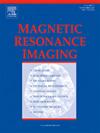基于prf的温度预报多基线拟合模型
IF 2
4区 医学
Q2 RADIOLOGY, NUCLEAR MEDICINE & MEDICAL IMAGING
引用次数: 0
摘要
MRI能够构建体内温度谱,为良恶性疾病提供精确的热指导,为肿瘤和良性结节提供微创、快速恢复和高重复性的治疗。尽管质子共振频率(PRF)测温仪具有实时热监测能力,但这种重要的基于磁共振的温度测量技术在肿瘤能量治疗中面临挑战,因为它容易受到图像对准误差和磁感应场变化的影响,导致温度跟踪不可靠。为了解决这些问题,本研究提出了一种基于质子共振频率的多基线拟合温度预测模型。该模型对k空间数据进行相位重构和去噪处理,去除背景相位噪声。然后动态生成多个相位差图,对ROI外的背景相位进行加权最小二乘拟合以纠正单帧相位失真,并使用信号放大因子(k)来补偿低温质子信号衰减。通过改变体模含水量、高温加热体模和低温冷冻体模的实验,对新模型和温度估计算法进行了验证。对比分析表明,改进效果显著:均方根误差(RMSE)从14.62°C/2.99°C降至2.19°C,最大误差从32.29°C/5.74°C降至3.64°C,拟合优度达到0.96,优于传统的单基线和多基线模型。值得注意的是,这项研究首次验证了PRF测温在零下环境(低至- 9.2°C)中的有效性,为冷冻消融治疗中的精确温度监测提供了一个强大的解决方案。这些进展解决了低温精密控制的关键技术挑战,为肿瘤冷冻消融提供了重要意义。本文章由计算机程序翻译,如有差异,请以英文原文为准。
A PRF-Based Multibaseline fitting model for temperature prediction
MRI is capable of constructing in vivo temperature profiles to provide precise thermal guidance for benign and malignant diseases and minimally invasive, rapid recovery and highly reproducible treatments for tumors and benign nodules. Despite the real-time thermal monitoring capabilities of proton resonance frequency (PRF) thermometry, this important magnetic resonance-based temperature measurement technique faces challenges in oncology energy therapy because it is susceptible to image alignment errors and magnetic induction field variations, resulting in unreliable temperature tracking. To address these issues, this study proposes a novel multibaseline fitting temperature prediction model based on proton resonance frequency. The model processes k-space data through phase reconstruction and denoising to remove background phase noise. Multiple phase difference maps are then dynamically generated, a weighted least squares fit to the background phase outside the ROI is performed to correct for single-frame phase distortions, and a signal amplification factor (k) is used to compensate for cryogenic proton signal attenuation. The new model and temperature estimation algorithm were tested by varying the water content of the phantom, heating the phantom at high temperature and freezing the phantom at low temperature experiments. Significant improvements are demonstrated by comparative analysis: the root mean square error (RMSE) reduces from 14.62 °C/2.99 °C to 2.19 °C, maximum error decreases from 32.29 °C/5.74 °C to 3.64 °C, and the goodness-of-fit reaches 0.96, outperforming conventional single- and multi-baseline models. Notably, this study validates PRF thermometry's efficacy for the first time in sub-zero environments (down to −9.2 °C), providing a robust solution for precise temperature monitoring in cryoablation therapies. These advancements address key technical challenges in low-temperature precision control, offering significant implications for tumor cryoablation.
求助全文
通过发布文献求助,成功后即可免费获取论文全文。
去求助
来源期刊

Magnetic resonance imaging
医学-核医学
CiteScore
4.70
自引率
4.00%
发文量
194
审稿时长
83 days
期刊介绍:
Magnetic Resonance Imaging (MRI) is the first international multidisciplinary journal encompassing physical, life, and clinical science investigations as they relate to the development and use of magnetic resonance imaging. MRI is dedicated to both basic research, technological innovation and applications, providing a single forum for communication among radiologists, physicists, chemists, biochemists, biologists, engineers, internists, pathologists, physiologists, computer scientists, and mathematicians.
 求助内容:
求助内容: 应助结果提醒方式:
应助结果提醒方式:


